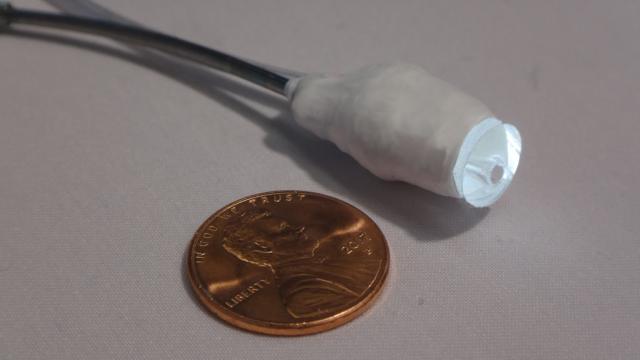During a recent experiment at Boston Children’s Hospital, bioengineers used a robotic catheter to reach a leaky valve inside pig hearts. But get this — the device was completely autonomous, navigating through the heart all by itself and without the benefit of a surgeon’s guiding hand. Welcome to the future of heart surgery.
New research published today in Science Robotics describes a robotic catheter that’s capable of moving autonomously inside a living body. In tests, the device navigated through beating, blood-filled pig hearts in search of its target—a leaky prosthetic valve.
Once at the scene, a surgeon took over to finish the repair. The senior investigator of this project, bioengineer Pierre Dupont from Boston Children’s Hospital, said this proof-of-concept experiment suggests autonomous surgical robots could be used for complex procedures, freeing up surgeons to focus on the most difficult tasks.
“The right way to think about this is through the analogy of a fighter pilot and [an autonomous] fighter plane,” said Dupont in a press statement. “The fighter plane takes on the routine tasks like flying the plane, so the pilot can focus on the higher-level tasks of the mission.”
In addition to relieving surgeons of a tiring, onerous task, a minimally invasive procedure such as this reduces chances of trauma and infection, which are associated risks of open heart surgery. Currently, robotic catheters are used during heart surgery, but they’re not autonomous, requiring a surgeon to manually move the device using joysticks. What’s more, a patient typically requires about 30 minutes of exposure to x-rays during the procedure, which is obviously not great.
A key to this breakthrough was the application of haptic vision—a form of “seeing” through the sense of touch. Inspired by the way insects and other creatures move around in dark or unfamiliar environments, Dupont and his colleagues developed a system capable of learning the lay of the land through touch.
In this case, the “land” was comprised of heart tissue. The robotic catheter was able to sense and creep along the tissue walls to reach a targeted location within the heart.
To enable the haptic vision, researchers at Dupont’s lab developed a proprietary optical touch sensor. This sensor, with the help of AI, a pre-programmed anatomy lesson, and pre-operative scans, told the catheter where it was located inside the heart and where it needed to go next.
The sensor, attached to the bottom end of the catheter, was able to recognise a heart wall, sense the presence of blood, and detect a valve. It also knew how strongly and how frequently it needed to exert pressure onto the tissue walls.
The catheter itself was comprised of concentric, telescopic tube robot technology. A “motorised drive system located at the base of the tubes rotated and telescopically extended the tubes with respect to each other to control the shape of the catheter and its tip position,” describe the authors in the new study.
In tests, the scientists used the autonomous catheter for a procedure known as paravalvular aortic leak closure, which is done to repair replacement heart valves that are leaking around the edges. Pigs were chosen for the experiment given the similarity of their anatomy to ours. The device was able to move inside the heart all by itself, eventually reaching the target.
From there, a surgeon took over, deploying a device from inside the catheter called an occluder to plug the leaky tissue surrounding the prosthetic valve. In total, five pigs were used over the course of 83 trials. The autonomous catheter reached its destination in 95 per cent of attempts, requiring around the same amount of time as a surgeon. The researchers weren’t able to detect any signs of bruising, scratches, or other tissue damage.
“This is a significant breakthrough, and an outstanding piece of work,” said Ellen Roche, an assistant professor at MIT’s Institute for Medical Engineering & Science, in an email to Gizmodo. “Autonomous catheters could be transformative in interventional cardiology and cardiac surgery, as well as for other surgeries.”
Roche, who wasn’t involved with the new research, was impressed by the use of haptic vision to achieve the autonomous control, saying it would be interesting to see how the system might work for procedures other than preventing leakage around an implanted replacement valve.
Nikolay Vasilyev, an assistant professor of surgery in the Department of Cardiac Surgery at Boston’ Children’s Hospital, liked the new approach, saying it could pave the way toward the development of autonomous image-guided robotic repairs, not only inside the heart, but also in thoracic (spine), vascular (veins and arteries), gastrointestinal, and other surgical procedures.
“One potential hurdle for wide clinical application, besides addressing safety questions and ensuring user adoption, is the technologies are developing much faster than regulations,” Vasilyev, who was not affiliated with the new study, wrote in an email to Gizmodo. “This may require close collaboration with regulatory agencies and potentially creation of new standards for regulatory approvals of autonomous medical robotic devices.”
That said, and as Roche explained to Gizmodo, it “typically it takes 3 to 7 years for approval for human use once the design is frozen, and has been submitted to the FDA, so likely a couple of years longer overall.” So it could be another decade before we see autonomous robotic probes slinking their way through our bodies during surgery. That should give regulators plenty of time to address potential safety and ethical concerns.
Which is a bit of a relief. The future of surgery will almost certainly involve increasing levels of robotic autonomy in a wide range of applications. If we’re going to have robots working in our bodies without the help of humans, we better get it right.
